China To US: We’re Ready To Fight If Needed And Russia Has Our Back
July 7th, 2016 | by hqanon
South China Sea — Beijing should be ready to “let the US pay a cost it cannot stand if it intervenes in the South China Sea dispute by force,” an editorial in a Chinese state-run paper warned on Tuesday — less than a week before the International Court at The Hague (ICH) is set to rule on a territorial disagreement between China and the Philippines.
“China hopes disputes can be resolved by talks,” wrote the Global Times, “but it must be prepared for any military confrontation. This is common sense in international relations.”
The dispute is over an island chain in the South China Sea, the Spratlys, and the maritime rights to the waters surrounding them. At the heart of the issue is sovereignty, with both China and the Philippines claiming territorial control.
In June of 2015, China announced that the artificial island chain it had been constructing in the South China Sea — in disregard of territorial claims by other Southeast Asian nations such as Vietnam, Taiwan, and Malaysia — would be completed within days. In the year that’s followed, the country has built military buildings, ports, and airstrips on the connected atolls.
In October of last year, the U.S. sent the first of what would become a considerable number of warships — and, eventually, even an aircraft carrier — into the South China Sea as a direct challenge to China’s claims in the region.
As pretext for involvement in what’s a wholly Southeast Asian affair, the U.S. has continuously claimed its allies in the region — notably India and the Philippines, itself — are concerned over China’s bold territorial assertions.
As Forbes recently wrote:
“While it is still unclear which way the ICH will rule, one thing is clear: China’s aggressive standing in the South China Sea disputes has spooked its neighbors.”
But China has made it clear it sees such U.S. involvement as military provocation.
“The South China Sea dispute has been greatly complicated after heavy US intervention,” the Global Times editorial states. “Washington…wants to send a signal by flexing its muscles. As the biggest powerhouse in the region, it awaits China’s obedience.”
Accordingly, China’s Maritime Safety Administration announced Monday it would be conducting military exercises in the waters of the South China Sea from July 5 to July 11 — the day before the ICH is set to make its ruling in the case brought before it by the Philippines.
“The drills are a very symbolic expression of China’s resolve,” Zhu Feng, dean of the Institute of International Affairs at Nanjing University, told TIME. “It is definitely also responding to the recent American warships patrolling in the South China Sea.”
Complicating the situation further is the fact that China, claiming the ICH has no authority to rule on territorial disputes, has repeatedly stated it has no intention of abiding by the tribunal’s ruling.
This inconvenience appears to be something the Pentagon is choosing to ignore, however, as evidenced by recent statements made by spokesperson Peter Cook and reported by Reuters:
“‘We’ve pointed to the diplomatic route for resolving these issues…they should be resolved peacefully,’ he said, adding the ruling from The Hague would provide an opportunity for this.’”
Wishful thinking, it seems, on the part of United States.
But there’s another, perhaps even more troubling facet of this entanglement that merits consideration. And, in point of fact, was not-so-subtly addressed in a recent article by another of China’s state-run publications, thePeople’s Daily.
And that facet can be encapsulated in a single word: Russia.
“China and Russia vowed to strengthen global strategic stability,” reports the Daily, “in a joint statement signed by Chinese President Xi Jingping and his Russian counterpart Vladimir Putin on June 25 during Putin’s visit to Beijing.”
Additionally, the Daily points out that “China and Russia have held six joint naval exercises since 2005”and that, for the 2016 maneuvers, “it is very likely that the South China Sea Fleet will take its turn as the main power, and the location might be near the South China Sea.”
If not a veiled threat, it’s at a minimum a reminder to the U.S. that China is far from alone in its military capacity.
And considering the NATO summit in Warsaw is only days away from approving the deployment of four battalions along the Russian border in Eastern Europe — and amid ongoing and increasingly dangerousconfrontations between the U.S. and Russia in Syria — it might do Washington, D.C., well to take China’s “reminder” to heart.

No comments:
Post a Comment
Comments always welcome!